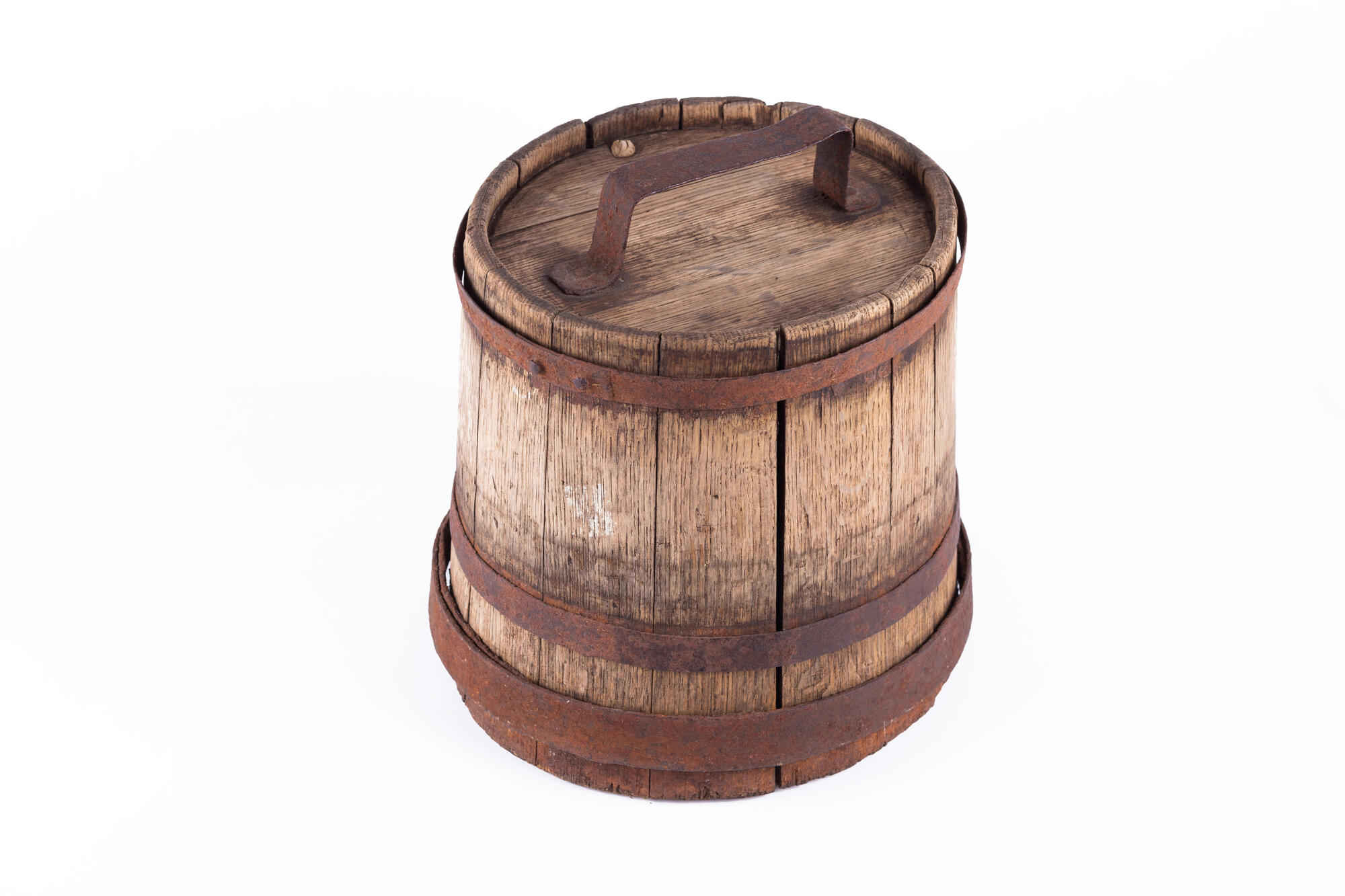Many artisans plied the cooper’s craft superbly, turning the production of jugs and pails, barrels and basins, tubs and buckets, mugs, milk pails, and glasses into a real art form. Cooperage entails a method of making vessels using wooden rivets, which are wooden billets hewn to the required thickness that have trapezoidal or oval ends. The museum’s collection showcases a terrific example of the cooper’s craft: a barrel for storing tar made in the 20th century.
Cooperage, in its original form, is unique in that only wood is used as a raw material. Using an axe and other carpentry tools, the cooper fastened the rivets, carving them out and fitting them to each other with the help of special rabbeted seams. The cooper then bound the entire framework together with wooden or iron hoops. Garden variety trees such as lilac, shadbush, bird cherry, or Bing cherry trees were usually used to make the hoops. Bark from linden, willow, oak, ash, elm, maple, and hazel trees was also used. The hoops reliably squeezed the framework’s rivets and ensured that the item was leakproof, without using glue and nails.
An item created using the techniques involved in cooperage can be taken to mean any object that has a base consisting of rivets strapped together with hoops and smoothly fitted to each other. Cooperage attached a lot of significance to the properties possessed by different types of wood. Artisans factored in the species of tree, humidity, conditions that the tree grew in, the season in which the timber was harvested, and other specific traits of the wood. Wielding their instruments with perfection, coopers understood the subtleties, and could feel the plasticity of the wood product. Familiar with the different qualities of certain species, they skillfully used them in the production of various items.
The cooper’s craft requires wood that splits cleanly, and is easy to plane and saw, but at the same time has sufficient elasticity and bends easily. That is why oak, hazel, linden, alder, birch, and poplar are widely used to produce rivets from deciduous trees, and in terms of conifers pine, spruce, cedar, larch, and juniper are widely used.
It is believed that oak is the best for the cooper’s craft, since it splits very well. In addition, oak is characterized by high elasticity, and becomes very flexible after it is treated with steam, and bends easily, which is a necessary quality in the manufacture of barrels. Also, dense and heavy oak wood dries well, and does not warp or crack that much. Oak wood can withstand the effects of moisture, on the contrary - when immersed in water it becomes even stronger.
Cooperage, in its original form, is unique in that only wood is used as a raw material. Using an axe and other carpentry tools, the cooper fastened the rivets, carving them out and fitting them to each other with the help of special rabbeted seams. The cooper then bound the entire framework together with wooden or iron hoops. Garden variety trees such as lilac, shadbush, bird cherry, or Bing cherry trees were usually used to make the hoops. Bark from linden, willow, oak, ash, elm, maple, and hazel trees was also used. The hoops reliably squeezed the framework’s rivets and ensured that the item was leakproof, without using glue and nails.
An item created using the techniques involved in cooperage can be taken to mean any object that has a base consisting of rivets strapped together with hoops and smoothly fitted to each other. Cooperage attached a lot of significance to the properties possessed by different types of wood. Artisans factored in the species of tree, humidity, conditions that the tree grew in, the season in which the timber was harvested, and other specific traits of the wood. Wielding their instruments with perfection, coopers understood the subtleties, and could feel the plasticity of the wood product. Familiar with the different qualities of certain species, they skillfully used them in the production of various items.
The cooper’s craft requires wood that splits cleanly, and is easy to plane and saw, but at the same time has sufficient elasticity and bends easily. That is why oak, hazel, linden, alder, birch, and poplar are widely used to produce rivets from deciduous trees, and in terms of conifers pine, spruce, cedar, larch, and juniper are widely used.
It is believed that oak is the best for the cooper’s craft, since it splits very well. In addition, oak is characterized by high elasticity, and becomes very flexible after it is treated with steam, and bends easily, which is a necessary quality in the manufacture of barrels. Also, dense and heavy oak wood dries well, and does not warp or crack that much. Oak wood can withstand the effects of moisture, on the contrary - when immersed in water it becomes even stronger.



